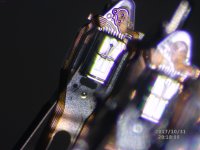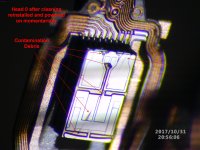So I got in a drive that was previously at another lab, who'd already attempted head swap unsuccessfully (I won't name them here).
I didn't really feel like wasting a perfectly good drive from my stock, so I devised this test method to see whether it was even a good candidate for recovery.
First, I removed the heads and inspected under my microscope. Sure enough there was some contamination on heads 0 and 1 as you can see here:

Next, I thoroughly cleaned all the sliders using my normal method (you can see it on youtube if you'd like) so they were completely clean and shiny.
Then, I reinstalled them and powered the drive on/off several times letting it click and report the usual servo errors.
Finally, I removed the heads again (they were clean a minute ago) and inspected them again.
What I found was this:
So after about 30 clicks from 5 or 6 power on cycles, the heads are already dirty enough they are unlikely to work.
So I think it's safe to assume this drive has a cascading failure on the bottom platter that will just continue to ruin any replacement heads. So, short of a Gillware "burnish and glide" treatment, I think it's safe to call this one a closed case.
I didn't really feel like wasting a perfectly good drive from my stock, so I devised this test method to see whether it was even a good candidate for recovery.
First, I removed the heads and inspected under my microscope. Sure enough there was some contamination on heads 0 and 1 as you can see here:

Next, I thoroughly cleaned all the sliders using my normal method (you can see it on youtube if you'd like) so they were completely clean and shiny.
Then, I reinstalled them and powered the drive on/off several times letting it click and report the usual servo errors.
Finally, I removed the heads again (they were clean a minute ago) and inspected them again.
What I found was this:
So after about 30 clicks from 5 or 6 power on cycles, the heads are already dirty enough they are unlikely to work.
So I think it's safe to assume this drive has a cascading failure on the bottom platter that will just continue to ruin any replacement heads. So, short of a Gillware "burnish and glide" treatment, I think it's safe to call this one a closed case.

